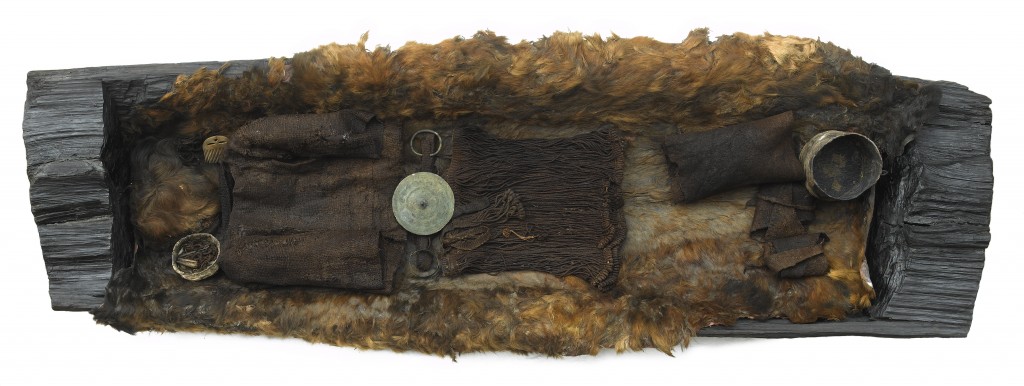
An iconic Bronze Age girl who was buried in Denmark about 3,400 years ago came from a foreign land, a new analysis of her hair and teeth suggests.
The Egtved girl was named after the village where she was found. All of her bones were missing from her remains, but her clothing, hair, nails and some teeth were still in pristine condition.
The new analysis, which was published today (May 21) in the journal Scientific Reports, suggests the woman may have spent her early life in southern Germany, making several long trips in the last two years of her life, said study co-author Karin Frei, a geologist and archaeology researcher at the National Museum of Denmark. [See Images of the Iconic Bronze Age Burial]
Ancient teenager
The girl's final resting place was first unearthed in in 1921, in a large burial mound made of peat bog. In addition to the remains of a 16- to 18-year-old girl, the oak coffin bore the cremated remains of a child, who was about 5 or 6 when he or she died.
The grave formed a unique microclimate: The acidic peat created a thin layer of iron around the coffin, which let rainwater seep into, but not out of, the coffin, Frei said. These acidic, oxygen-free, waterlogged conditions led to the decay of the bones but left her hair, nails and clothing intact, Frei said.
The Bronze Age teenager was wearing a wool skirt belted with a large bronze disk with spirals on it.
Sign up for the Live Science daily newsletter now
Get the world’s most fascinating discoveries delivered straight to your inbox.
"She looks, in a way, very modern, in this kind of miniskirt and a kind of T-shirt," Frei told Live Science. (Her unique fashion sense has inspired scores of Pinterest-worthy re-enactments.)
Figurines from the Bronze Age show women in similar dress, with spiral symbols associated with a Scandinavian sun cult, so historians have concluded the girl must have been a priestess of that cult, Frei said. [Photos: Ancient Bronze Age Sundial]
Long-distance traveler
Frei first analyzed strontium isotopes, or atoms of the element with different numbers of neutrons, in the wool skirt. Because the rocks in different regions contain different ratios of strontium isotopes, which are then taken up by the plants, animals and people who eat in that region, the ratio can reveal where a person or animal lived.
The wool was not from anywhere near Denmark, and likely came from near the Black Forest in Germany, the team found.
Next, Frei analyzed a portion of the girl's hair and a molar tooth, which forms early in childhood and doesn't change after that. The girl had about 9 inches (23 centimeters) of hair at the longest point, and hair grows about 0.4 inches (1 cm) per month, allowing the team to recreate the last two years of her life.
"She moved from one place outside Denmark, to a place that could be Denmark, to a place very far from Denmark," where she spent a large portion of the last six months of her life," Frei said. "She probably died or got sick and died very shortly after her arrival to Egtved," Frei said.
Given how many trips the girl made over long distances, she was likely traveling quickly by boat, Frei said.
The cremated cranial bones of the child buried alongside the Egtved girl revealed he or she spent much time in the same distant region as the Egtved girl.
Denmark and southern Germany were centers of power at the time, so the southern German girl was likely married in a strategic power alliance to a chieftain in Denmark, and may have been traveling back to her hometown in her last years. The two individuals may or may not have been related; either way, the youngster spent time in the same rough locale as the Egtved girl.
Long-distance trade
The study shows that Bronze Age people were not just trading, but were traveling long distances, said Flemming Kaul, a curator of prehistory at the National Museum of Denmark, who was not involved in the study.
Nordic amber has been found, like a trail of breadcrumbs, along rivers and beaches in Europe and in the Mediterranean. Meanwhile, blue glass beads from Egypt and Mesopotamia have been found in Scandinavian graves, according to a study published in January in the Journal of Archaeological Science. And the bronze used to make the girl's sun-cult belt decoration wasn't from Denmark, but instead had to have come from somewhere like the Alps, he added.
The new finds suggest these goods weren't just traded over short distances hand-to-hand, but that people were venturing to far-flung lands themselves, Kaul told Live Science.
Follow Tia Ghose on Twitter and Google+. Follow LiveScience @livescience, Facebook & Google+. Originally published on Live Science.

Tia is the managing editor and was previously a senior writer for Live Science. Her work has appeared in Scientific American, Wired.com and other outlets. She holds a master's degree in bioengineering from the University of Washington, a graduate certificate in science writing from UC Santa Cruz and a bachelor's degree in mechanical engineering from the University of Texas at Austin. Tia was part of a team at the Milwaukee Journal Sentinel that published the Empty Cradles series on preterm births, which won multiple awards, including the 2012 Casey Medal for Meritorious Journalism.










